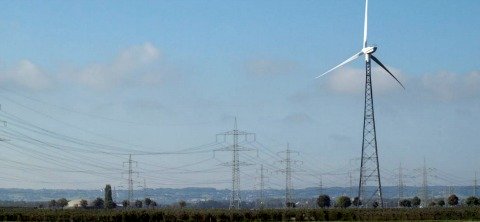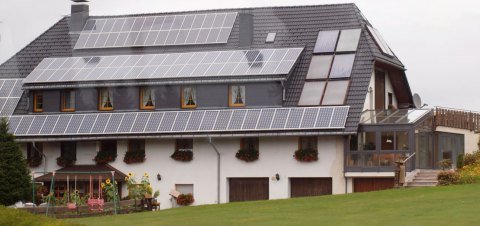Home | About CCW | Contact Us | Climate change Meaning | Causes | Solutions | Emissions | Carbon trading
Green power
Green power is an energy source that is environmental friendly and non-polluting, specifically with respect to greenhouse gas emissions.
Power that conforms to these criteria is also known as renewable energy, alternative energy, alternative fuels or clean energy and is produced through so-called alternative energy technologies and clean technologies.
The usual suspects on any list of such power sources include
- geothermal
- wind
- solar
- hydro
- wave and tidal
- anaerobic digestion
- biomass
Some people like to add nuclear power to this list based on the idea that nuclear power stations are non-polluting with regard to greenhouse gases but the high risk from accidents means its hard for nuclear to pass the environmentally friendly test.
There are other options, such as hydrogen fuel cells and even fusion power that are known but not yet viable at commercial scale - the key word being ‘yet’.
Given there are many options for alternative energy surely they must be doing the job and helping reduce emissions

The US Department of Environment’s Energy Information Administration provides official energy statistics from the US government that make for interesting analysis.
The total world energy use in 2006 was 472 quadrillion Btu (138,200 terawatt hours), one third more than in 1995 and is projected in modeling completed by the EIA to reach 678 quadrillion Btu (198,700 terawatt hours) by 2030 – close to double the 1995 amount.
This gives you some idea of the size of the CO2 emission reduction task proposed in international agreements such as the Kyoto protocol. A 20% reduction below 1990 levels is a tall order when already high global energy consumption is growing at 1.5% per annum.
People living in the OECD countries use just over half the global energy produced – in 2006 this was 1.7 billion people or 18% of the global total.
This is an awkward disparity.
A fifth of the people use half the energy. It will not stay this way, the other four fifths will catch up for they too want warm homes, transport and plasma screen televisions.
In 2006 renewable energy solutions, excluding biofuels and nuclear, provided 7.8% of the global energy supply. This proportion is expected to rise at 3% a year over the coming decades.
Biofuels, energy from recently living biomass, is interesting in itself.
Incentives for clean energy is one very strong reason for emissions trading schemes. They are designed to create a price pressure on dirty energy, an investment incentive to generate green power and a flow of capital to make it all happen.
But it is a huge leap from 7.8% to, let’s say, 50% of global supply. The absolute amount of energy that would have to be produced is huge.
Even at a growth of 3%, alternative sources will only reach 10.9% of the total supply by 2030.
The EIA data has coal at 27.0% of the total in 2006 and projects 28.0% by 2030. The extra 3.1% from green power barely takes up the slack from declines in petroleum use.
So how will we reduce CO2 emissions?
At the moment we are going to rely on carbon capture and storage to make the coal-fired power stations clean.
Should we purchase green power?
In many countries it is possible to purchase alternative power from a utility company or a renewable energy provider. These retailers buy the electricity from electricity producers who may be generating from fossil fuel, nuclear or renewable energy sources. Often green energy sources provides a very small amount of electricity, generally contributing less than 2 to 5% to the overall pool. It is hard for the proportion to be much higher when total capacity from alternative sources is less than 8% of the total global power use.
So can we be sure that when we select the green power option from an energy retailer they will buy genuine green energy? Well no, not really. Requests for clean energy do help to promote alternatives and sends a signal to policy makers that we are willing to pay a price premium to support renewable energy.

High demand should obligate the utility companies to either increase the amount of green energy that they purchase from the pool (so decreasing the amount of non-green energy they purchase), or directly fund the green energy through a alternative energy provider.
When the green energy sources cannot meet the demand the utility should develop new ones or contract for supply from third parties so that more capacity is built.
When the power coming down the line into your house is just electricity from the grid it is impossible to know if this electricity is "green" or otherwise.
Given the way western countries generate and distribute electricity the shift to cleaner power will not be easy.
If we started from scratch then we could have a distributed network with smaller power nodes supplied by many different sources. We could see wind farms, solar arrays, wave energy on the coast and a whole range of fuel cell options. But, for the moment, we are stuck with our national grids and big power stations.
Green power for all will take a while.

some homes like this one in Germany are already designed to run on green power
Back to top of green power | Return from Green power to Solutions for global warming |Back to climate-change-wisdom home page
Recent Articles
-
Reducing emissions while looking for solutions...
Nov 01, 15 04:46 PM
I've seen a lot of post's online for ideas on reducing emissions. The one suggestion I have not seen, is the most obvious. There should be a government -
Climate change evidence
Mar 24, 15 06:22 AM
Real climate change evidence has to demonstrate a change in climate. An extra sunny day or a severe storm or a flood is not enough. -
The climate change effect
Feb 19, 15 03:08 AM
What will be the climate change effect? There isn't one, there are many. Perhaps too many for us to understand.

New! Comments
Have your say about what you just read! Leave me a comment in the box below.